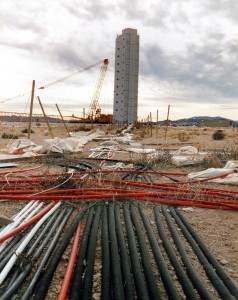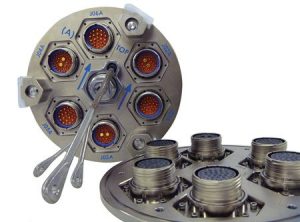I dedicate the following rant to my Lovely Assistant, who can probably recite this by heart now, and Meredith Yayanos who hit boggleface about halfway through an in person version and asked “PLEASE, WRITE THIS SHIT DOWN.” Now I have.
Let’s say, for the sake of argument, that you have a brand new nuclear weapon. Let’s not quibble for the moment over how it came to be. Perhaps you decided the Reliable Replacement Warhead program was a good idea after all and grabbed one of the designs that were put forward in the twilight of Bush/dawn of Obama and built it. Perhaps you had a brand new one whipped up and it’s gonna be great! All that matters is that you have it.
But does it actually work? The computer models say it’s A+, hunky dory, best nuke ever. Except now it’s a physical object, not a simulation. Were the engineering tolerances right? Did we get the metallurgy down? WILL IT ACTUALLY WORK?!?! Unless you can convince the brass that it does, they won’t order this new design, much less deploy it. And you won’t know unless you set it off, as a representative of a new fleet of nuclear weapons. And so begins the Choose Your Own Nuclear Adventure!
Question 1: Do you want to test it above ground (AKA atmospheric) or underground?
Atmospheric testing does have its benefits, namely that it’s comparatively easy to do and, by jingo, people will know that you set off a nuclear device. Very showy and attention getting, great media coverage I bet. Here’s a few demonstration videos. There is this one slight drawback in that Kennedy kinda, sorta signed a treaty and Congress ratified it 54 years ago that we said we wouldn’t do atmospheric testing anymore. That will make some people very unhappy. But you do you. Please enjoy this instructional video.

Underground testing then? Well, that’s a little more tricky but luckily we used to have a place where we did a lot of this. Assuming you’d like to go back to the former Nevada Test Site to start “stomping our feet” again rather than create a brand new national sacrifice area, I’ve got some great news! When we temporarily stopped underground testing (I say “temporarily” because you’re about to test again) in 1992 under the limited nine month moratorium that got extended into the Comprehensive Test Ban Treaty (CTBT), we had another hole ready to go for the ICECAP test which never happened. You may remember this from my previous post about the Nevada Test Site. All we have to do is put our new device down that hole, connect it up to the diagnostic equipment, backfill and good to go, right?
Well, as a reminder, you will make some people upset with that whole violating the CTBT. On a positive note, you won’t actually be in violation of US law because, while the Clinton administration signed off on it, Congress never ratified the treaty like they did thirty years earlier with the atmospheric testing ban. If you look at the map under the CTBT link, you’ll notice that of the nuclear powers signed off on this, the United States and China are two that conspicuously did not ratify. The more recent additions to the Nukehaver Club (India, North Korea, and Pakistan) you’ll note are non-signatories. You can’t quite yell at them for violating a treaty they didn’t even sign, other than as a neighbor who is rather cranky.
But maybe the ICECAP setup isn’t right for our new device to test. Maybe you just feel a brand new nuke needs a brand new tunnel and shaft. Can’t use another bride’s wedding dress after all. Which brings us to the next question.
Question 2: Do you have the equipment to build this?
If you visit the Atomic Testing Museum in Las Vegas, NV you will get a chance to see the amazing mining technologies developed to build these tunnels and shafts. To run thousands of miles of cables, which you can see some of in the ICECAP picture, to collect all the test data and run them from the device back to “Mission Control” where the shot director is running the show with all the computers. I regret to inform you that the tunneling equipment is likely either gone, probably sold as gov’t surplus/scrap metal long ago, or it is in the condition that most things are when you abandon them in desert with no maintenance for 25 years. For example, that crane-like thing in the background of the ICECAP picture. I strongly recommend getting a tetanus booster before getting within 100′ of that much rust. Also, you need a new one of whatever that is if you want to pull those cables. Oh, and FYI, you need to replace all those cables as the insulation on wires reacts even worse to 25 years of open air exposure in the baking Nevada desert than the crane-thing did. Even if you wanted to recycle the ICECAP hole, assuming it was adequate for your test, you have to replace absolutely everything you see in this picture.
Actually, there’s a good chance the digging equipment, the moles, are still around, as they are incredibly expensive, but they may not be anywhere convenient and probably are in active use. If you want to call it back to cut some new shot tunnels, you’ve got to make some hard choices as to which other critical infrastructure project around the country you’d like to give up on. I suppose you could order a new one, though people do tend to ask what multi-billion dollar infrastructure project you’re going to be doing with it.

Okay, let’s say you’ve appropriated, and not ask too hard about how you did it, all the requisite equipment. That probably cost a few billion bucks. You went out to the cable spools you saw sitting in the desert, ordered more and are ready to hook it all together. Then you see a connector that looks like this at the end of the cable.
Umm, uh oh. Your new nuclear device doesn’t have such a connector as it was designed and built in the 21st century. Neither, for that matter, does any of the diagnostic equipment you bought off the shelf from a variety of suppliers to save on procurement costs.
You see, you don’t just need to replace all the equipment that was once there. You need to either completely reconstitute the state of technology as it was in 1992, which was probably something close to early 1980s state of the art as we tend to be rather picky about choosing very reliable and tested equipment with lots of spare parts, or you need to update Every. Last. Goddamn. Thing. involved in a nuclear test to the current state of the art. The latter course requires you to qualify all these technologies as “nuclear test worthy” reliable and that’s gonna take a while and quite a lot of money too. Doing the former, partying like it’s 1992, probably isn’t any cheaper and it may just flat not be possible. All the old suppliers have moved on to making other things and there may be no parts left.
This includes all the computers. I really can’t do justice to how non-trivial that upgrade is and the QA the software will require. The Computer History Museum will get stripped bare if you choose the time capsule method of restarting operations. Either way, I figure we’re getting into the hundreds of billions of dollars and several years of effort territory here.
Which brings us to a tiny, minor problem. Hardly worth mentioning, really.
Question 3: Do you have the people to run any of the equipment, or the test itself?
Much like pulling a mole off an infrastructure project has an opportunity cost of not doing that project, you’re going to need to pull that work crew too. Can you convince them to, for example, move from Seattle where they’re working on replacing WA-99 Alaskan Way Viaduct and move to North Las Vegas? Or Pahrump, NV of Art Bell fame? Maybe, but I suspect you’ll be paying a hefty premium for them. This isn’t the Medieval Europe with the corvée to compel public service, so you have to pay for these skilled workers. Oh, and you’re gonna have to get them all clearance.
Repeat with each and every one of the trades you’re going to need. Especially IT support. Hooboy, this is getting incredibly expensive now.
But wait, what about all the workers who are already there, can’t we just use them? Well, no. The people who once worked the nuclear tests have either:
- Retired at some point in the last 25 years.
- Long since moved on/been laid off since testing stopped 25 years ago.
- Died at some point in the last 25 years.
Precious few people who worked in the nuclear weapons program, involved with actual tests, are left in government employment. More than you might expect, as they tend to hang around longer than others out of a sense of mission, but less every year. I suppose you could call up folks and see if they’d like to leave retirement to add some knowledge base to your project, but you’re looking at folks with decades rusty skills who you’re asking to either do a technological leapfrog OR download their complete career knowledge into newbies in short order. One of the many arguments for not continuing the moratorium through the end of the 1990s was precisely to keep this expertise available and sharp, but such is life and we did not.
People are gonna screw up developing these skills. They’re going to be slow at first as they learn. If you try to rush this, bad things happen. There is a saying from the American testing program, a point of pride, “We never screwed up the same thing twice. Can’t think of a lot of government agencies that can claim that.” I’d like them to keep that streak going, but I’d prefer they not screw something up in a new and instructive way.
MORAL OF THE STORY
If you have a nuclear device you want to test RIGHT NOW, you might as well give it to North Korea. They’ve got fresh and sharp skills. It’ll take us, and Russia for that matter, several years and a hell of a lot money to stand up a functional and ongoing nuclear testing program again.
This is the primary reason why the United States built the National Ignition Facility (NIF). If I can’t go set off the old nuclear weapons in Nevada to see if they’re working properly, can I take tiny pieces of those weapons and simulate blast conditions on them with a laser-based artificial star to see how they behave? Oh sure, we’ve found a lot of other pretty neat science the NIF can contribute to as the years have gone on, but this is its original purpose: stockpile verification. Russia, on the other hand, never built an equivalent of NIF. Other than setting them off, they don’t have a method to test their stockpile. Unlike the United States, the Yeltsin administration not only signed the CTBT but the Duma ratified it. It would be tacky for Russia to unilaterally resume testing.
Of course, if we resumed testing on our own and tossed the CTBT in the trash can, then it would just be sensible policy on their part.